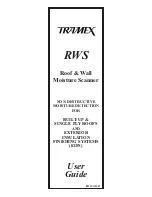
For example, walls or roofs on ocean-side properties
may have higher salt content on the surface and thus
slightly higher readings than inland properties, or sur-
face moisture may dry off more slowly depending on
orientation of the wall or roofs.
The
RWS
is designed to have the flexibility in
sensitivity adjustment to cope with variances caused by
material and conditional differences from wall to wall.
Tracing Moisture Back To Source
In EIFS Or Similar Construction
Once an area of excess moisture has been established,
the
RWS
may be used to assist in tracing the moisture
to the source of ingress as follows:
Having found a wet area, turn down the SENSITIVITY
knob until the needle points to approximately half scale
(approx 50).
On this setting, take further readings around the area,
note the highest reading and follow in the direction of
the highest reading. If necessary, decrease sensitivity
until the area of greatest moisture has been located.
Usually the greatest moisture concentration is in the
proximity of the area where the moisture is getting into
the system. A careful visual examination in this area
should be carried out to identify defects or damage in
weatherproofing.
Taking core samples of the EIFS or foamed roof insula-
tion and / or the use of a pin type resistance meter such
as a TRAMEX
COMPACT or PROFESSIONAL
with
deep wall probes is recommended to substantiate and
quantify the
RWS
readings.
Fig. 4.
Professional Pin Meter With Deep Wall Probe.
R.W.S.
User Guide
Summary of Contents for RWS
Page 18: ... R W S User Guide ...



















